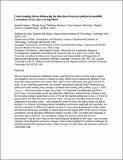| dc.contributor.author | Giang, Amanda Chi Wen | |
| dc.contributor.author | Song, Shaojie | |
| dc.contributor.author | Muntean, Marilena | |
| dc.contributor.author | Janssens-Maenhout, Greet | |
| dc.contributor.author | Harvey, Abigail P. | |
| dc.contributor.author | Berg, Elizabeth (Elizabeth J.) | |
| dc.contributor.author | Selin, Noelle E | |
| dc.date.accessioned | 2020-07-13T14:33:04Z | |
| dc.date.available | 2020-07-13T14:33:04Z | |
| dc.date.issued | 2018-09 | |
| dc.date.submitted | 2018-06 | |
| dc.identifier.issn | 2050-7887 | |
| dc.identifier.issn | 2050-7895 | |
| dc.identifier.uri | https://hdl.handle.net/1721.1/126148 | |
| dc.description.abstract | We used chemical transport modelling to better understand the extent to which policy-related anthropogenic mercury emissions changes (a policy signal) can be statistically detected in wet deposition measurements in the Great Lakes region on the subdecadal scale, given sources of noise. In our modelling experiment, we consider hypothetical regional (North American) and global (rest of the world) policy changes, consistent with existing policy efforts (Δglobal = −18%; Δregional = −30%) that divide an eight-year period. The magnitude of statistically significant (p < 0.1) pre- and post-policy period wet deposition differences, holding all else constant except for the policy change, ranges from −0.3 to −2.0% for the regional policy and −0.8 to −2.7% for the global policy. We then introduce sources of noise—trends and variability in factors that are exogenous to the policy action—and evaluate the extent to which the policy signals can still be detected. For instance, technology-related variability in emissions magnitude and speciation can shift the magnitude of differences between periods, in some cases dampening the policy effect. We have found that the interannual variability in meteorology has the largest effect of the sources of noise considered, driving deposition differences between periods to ±20%, exceeding the magnitude of the policy signal. However, our simulations suggest that gaseous elemental mercury concentration may be more robust to this meteorological variability in this region, and a stronger indicator of local/regional emissions changes. These results highlight the potential challenges of detecting statistically significant policy-related changes in Great Lakes wet deposition within the subdecadal scale. | en_US |
| dc.publisher | Royal Society of Chemistry (RSC) | en_US |
| dc.relation.isversionof | http://dx.doi.org/10.1039/c8em00268a | en_US |
| dc.rights | Creative Commons Attribution-Noncommercial-Share Alike | en_US |
| dc.rights.uri | http://creativecommons.org/licenses/by-nc-sa/4.0/ | en_US |
| dc.source | Prof. Selin via Phoebe Ayers | en_US |
| dc.title | Understanding factors influencing the detection of mercury policies in modelled Laurentian Great Lakes wet deposition | en_US |
| dc.type | Article | en_US |
| dc.identifier.citation | Giang, Amanda et al. "Understanding factors influencing the detection of mercury policies in modelled Laurentian Great Lakes wet deposition." Environmental Science: Processes & Impacts 20, 10 (September 2018): 1373-1389 | en_US |
| dc.contributor.department | Massachusetts Institute of Technology. Institute for Data, Systems, and Society | en_US |
| dc.contributor.department | Massachusetts Institute of Technology. Department of Earth, Atmospheric, and Planetary Sciences | en_US |
| dc.contributor.department | Massachusetts Institute of Technology. Center for Environmental Health Sciences | en_US |
| dc.relation.journal | Environmental Science: Processes & Impacts | en_US |
| dc.eprint.version | Author's final manuscript | en_US |
| dc.type.uri | http://purl.org/eprint/type/JournalArticle | en_US |
| eprint.status | http://purl.org/eprint/status/PeerReviewed | en_US |
| dspace.date.submission | 2020-07-08T17:15:33Z | |
| mit.journal.volume | 20 | en_US |
| mit.journal.issue | 10 | en_US |
| mit.license | OPEN_ACCESS_POLICY | |
| mit.metadata.status | Complete | |
